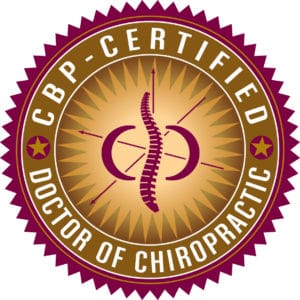
Chiropractic Biophysics
There is no replacement for a skilled set of hands being able to detect and adjust subluxations. CBP offers an additional “missing piece” to this health care puzzle through a combination of precise postural corrective exercises, postural corrective adjustments, and corrective traction (spinal remodeling).
In a true CBP Corrective Care practice, when a patient is going through care, x-rays are taken initially to precisely measure and analyze to see if one’s spine is “within normal limits” compared to an ideal model. If a patient is a candidate for CBP Corrective Care, a specific treatment plan will be designed, and at various intervals of care, comparative x-rays will be obtained to gauge progress and measure the objective changes.
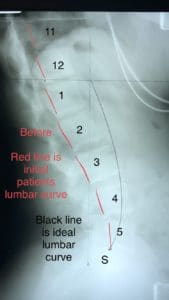
Chiropractic Biophysics Lumbar Analysis Before Optimus Spine & Posture
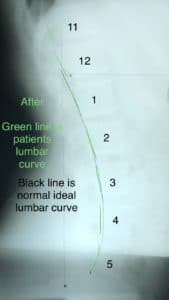
Chiropractic Biophysics Lumbar Analysis After Optimus Spine & Posture Treatment 36 Visits
What is Chiropractic BioPhysics (CBP), and why should you care?
Chiropractic BioPhysics is a technique that is only practiced by chiropractors who invest in a large amount of extra education and equipment. It takes time, money, and extra effort to become a certified CBP practitioner. Dr. Gareth Bury is the only Basic CBP practitioner in Greensburg, PA and all of Westmoreland County!
CBP practitioners don’t have magical adjusting powers, they are simply trained to use science to diagnose a problem, and use a unique treatment (traction) to correct the problem. It is the only technique to demonstrate consistent, published evidence of it’s effectiveness in correcting the shape of the spine towards an established normal value.
The established normal value for the shape of the spine was missing until a CBP study proposed a geometric, measurable shape. CBP practitioners examine spines, measure how far they’ve deviated from normal, decide if that might be involved with pain or dysfunction, and correct the spine towards normal if necessary.
The most basic example of this is reducing forward head carriage in people with neck pain. It is just common sense that having your head stick straight forward is going to put stress on the neck and mid-back. But CBP studies are some of the first to consistently document the physical correction of these conditions. The same idea can be applied to the whole spine. Each area of the spine has well-defined deviations. Some are very common and some are rare. CBP training focuses on identifying all of these different types of deviations, and each deviation is paired with a technical protocol for correcting the issue. Each protocol is unique.
CBP is more than posture, it is about curvature.
Posture gets a bad rap from therapists. Everyone seems to be a posture expert, and makes these outrageous claims of how correcting posture fixes this or that. Obviously some of this must be true, but the therapists disagree about so much. CBP practitioners look one layer deeper than just posture. We also look at spinal x-rays, and determine the curvature of the spine. This is critical, because posture alone does not give information about the curvature of the spine.
Lets take the example of head posture and neck curvature. A person could have absolutely perfect head and shoulder posture where their head is perfectly seated on their neck, and even with the shoulders (imagine we are looking from the side). Everyone would agree that this person has great posture. But what if this person was suffering from severe neck pain? How could a therapist who only focused on posture help? By taking an x-ray of this person’s neck we would be able to see if he had a normal curve where the peak of the curve points towards the throat, or a reversed curve where the peak of the curve points towards the back of the neck. Thus, we could tell if this person with perfect posture had a neck that had a normal curve or an abnormal curve. This gives us options for treatment where traditional posture-focused treatments would run out of options.
CBP practitioners are essentially experts in using traction to correct the spine.
This part is boring, but important. Traction is a unique therapy that is distinct from other therapies like exercise, stretching, adjustments, heat, ice, etc. Traction is a sustained stretch applied to joints that are relaxed. It is intended to change the structure of ligaments, which hold the spine locked into a unique shape for each individual. Traction is sometimes used in surgery for a completely different purpose, and it is also sometimes used by Physical Therapists and other therapists to “decompress” injured discs. The type of traction used by CBP practitioners is very different from either of these types of traction.
CBP traction involves bending, and it sometimes utilizes combinations of different pulls to change the shape of the spine. General chiropractors, physical therapists, and medical doctors are unfamiliar with these techniques and do not offer them as treatments. This is why CBP practitioners get substantially different (and better) results.

Why use CBP?
CBP is all about creating long term relief. Chiropractic can do so much more than short term pain relief. The technique combines traction with the chiropractic adjustment, specific exercises and focused stretching. These therapies are made just for you, based off of the unique shape of your spine.
The combination of traction, exercise, and adjustments produces measurable changes to the shape of your spine. These changes last, and allow the spine to fully heal. CBP is the only technique proven to do this consistently in peer-reviewed research.
Call or email our office to learn if you may be a candidate for this technique. This technique has successfully treated complicated cases like low back pain with radiculopathy, and neck pain with migraine headaches.
Dr. Bury is CBP certified and learned from some of the best doctors in the world at Ideal Spine in Idaho. He recently just got back from the Cervical Rehab seminar in Nashsville. To learn more about this corrective method visit IdealSpine
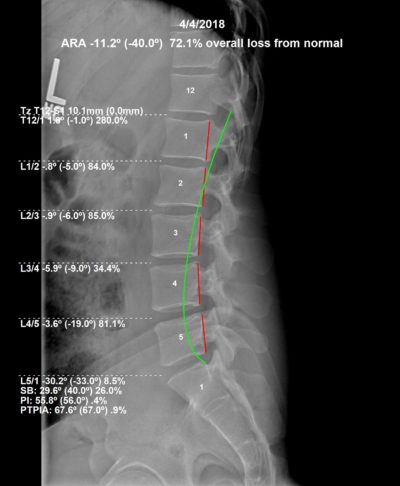
Chiropractic Biophysics Optimus Spine & Posture analysis
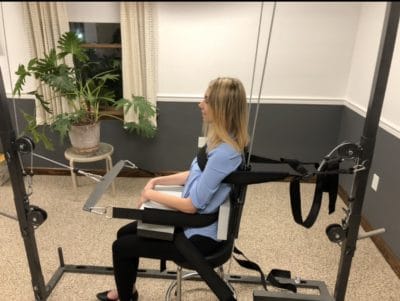
Chiropractic Biophysics Universal Traction System Optimus Spine & Posture
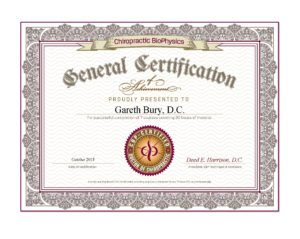

Chiropractic Biophysics Pre Post X-Ray Analysis
